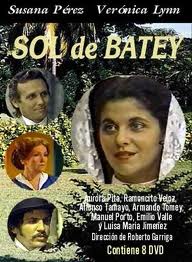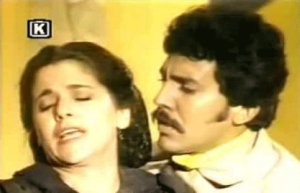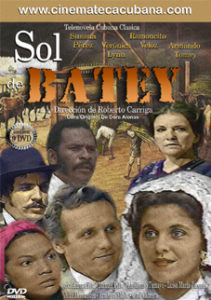CUBAN TELENOVELA “SOL DEL BATEY” FINALLY LIBERATE OUR NATIONAL CREATION OF THE EXHAUSTED ‘REALISMO MARXISTA’.
Like a folklore in the style of The Count of Montecristo, or a Mexican melodrama in the line of those who counted the sufferings of despised and ultimately redeemed women, the classic Cuban telenovela, free of marxist and sociological remnants, returned to the Cuban screens by ‘Sol de batey’, released in 1985, as a result of the incredible success in Cuba of the Brazilian ‘The slave Isaura’.
However, ‘Sol de batey’ could exist without the conditioning of the Brazilian serials, since it rather gave continuity to the Cuban telenovela tradition, since in Cuba the first ones were produced in Latin America in the early fifties. With classics such as Felix B. Caignet’s ‘Right to Be Born’ among others. In addition, the same anecdote was recreated on screen as a homonymous radionovela by Dora Alonso, released in 1951, so it was more related to Cuban history and artistic and cultural traditions than to the powerful influence of Brazilians.
At the time of the release of Sol de batey, the Cuban telenovela had become extinct among the Horizons trying to adapt their codes to the dictates of socialist realism, or television adaptations of great romantic or realist novels Doña Bárbara (1977), El rojo y el negro (1979), Wuthering Heights (1981) and The Impure (1984).
In the mid-1980s, Cuban Television attempted to catch up with ‘Sol de batey’, which rediscovered the past through the dominant codes in Cuban soap operas and soap operas of the 1950s, with certain touches of modernity such as the incest suggested between the Father and the aunt of the protagonist, or the overwhelming sensuality of the relationship between the slaves.
An experienced director like Roberto Garriga was in charge of recycling this radionovela that told two parallel love stories: one among young criollos heirs of exclavista saccharocracia (Susana Pérez and Armando Tomey) while the other impossible love story occurred between slaves, Liberato And Tojosa, interpreted with all conviction by Idelfonso Tamayo and Luisa María Jiménez.
Nor should we forget the presence of two experienced television and theater actresses: Aurora Pita and Veronica Lynn, who embodied good aristocracy and bad aristocracy, while Ramoncito Veloz gave face to one of the worst wicked that recalls Cuban television.
In 1994, another former soap opera and soap opera by Dora Alonso, Medialuna, became the most successful Tierra Brava, but that is another story, confirming the triumphant revenge of the Cuban folklore and melodrama, so often vituperated, denied, exiled and forgetting our best National traditions.
TELENOVELA CUBANA “SOL DEL BATEY” LIBERA FINALMENTE A NUESTRA CREACIÓN NACIONAL DEL AGOTADO ‘REALISMO MARXISTA’.
Al igual que en un folletín al estilo de El conde de Montecristo, o un melodrama mexicano en la cuerda de aquellos que contaban los sufrimientos de mujeres despreciadas y al final redimidas, la telenovela cubana clásica, libre de resabios marxistas y sociológicos, regresó a las pantallas cubanas mediante Sol de batey, estrenada en 1985, como resultado del increíble éxito que tuvo en Cuba la brasileña ‘La esclava Isaura’.
Sin embargo, Sol de batey pudo existir sin el condicionamiento de los seriados brasileños, puesto que más bien daba continuidad a la tradición telenovelera cubana, pues en Cuba se produjeron las primeras generadas en América Latina, a principios de los años cincuenta. Con clásicos como el ‘Derecho de Nacer’ de Félix B. Caignet entre otros. Además, se recreaba en pantalla la misma anécdota que una radio novela homónima de Dora Alonso estrenada en 1951, por lo tanto estaba más relacionada con la historia y las tradiciones artísticas y culturales cubanas que con la influencia, poderosa, de los brasileños.
Cuando se estrenó Sol de batey, la telenovela cubana se había extinguido entre los Horizontes que intentaban adaptar sus códigos a los dictados del realismo socialista, o las adaptaciones televisivas de grandes novelas románticas o realistas estilo Doña Bárbara (1977), El rojo y el negro (1979), Cumbres borrascosas (1981) y Las impuras (1984).
A mediados de los años ochenta la Televisión Cubana intentó ponerse al día con ‘Sol de batey’, que redescubría el pasado mediante los códigos dominantes en la radionovela y telenovela cubanas de los años cincuenta, con ciertos toques de modernidad como el incesto sugerido entre el padre y la tía de la protagonista, o la sensualidad desbordada de la relación entre los esclavos.
Un director experimentado como Roberto Garriga fue el encargado de reciclar esta radionovela que contaba dos historias de amor paralelas: una entre jóvenes criollos herederos de la sacarocracia exclavista (Susana Pérez y Armando Tomey) mientras que la otra historia de amor imposible ocurría entre esclavos, Liberato y Tojosa, interpretados con toda convicción por Idelfonso Tamayo y Luisa María Jiménez.
Tampoco debe olvidarse la presencia de dos experimentadas actrices de la televisión y el teatro: Aurora Pita y Verónica Lynn, que encarnaban la aristocracia buena y la mala, mientras que Ramoncito Veloz le daba rostro a uno de los peores malvados que recuerda la televisión cubana.
En 1994, otra antigua radionovela y telenovela de Dora Alonso, Medialuna, se transformó en la exitosísima Tierra brava, pero eso ya es otra historia, que volvía a confirmar la venganza triunfal del folletín y el melodrama cubanos, tantas veces vituperados, negados, desterrados, olvidando nuestras mejores tradiciones Nacionales.
Agencies/CiberCuba/Joel del Río/internet Photos/YouTube/ Arnoldo Varona/ TheCubanHistory.com
THE CUBAN HISTORY, HOLLLYWOOD.








